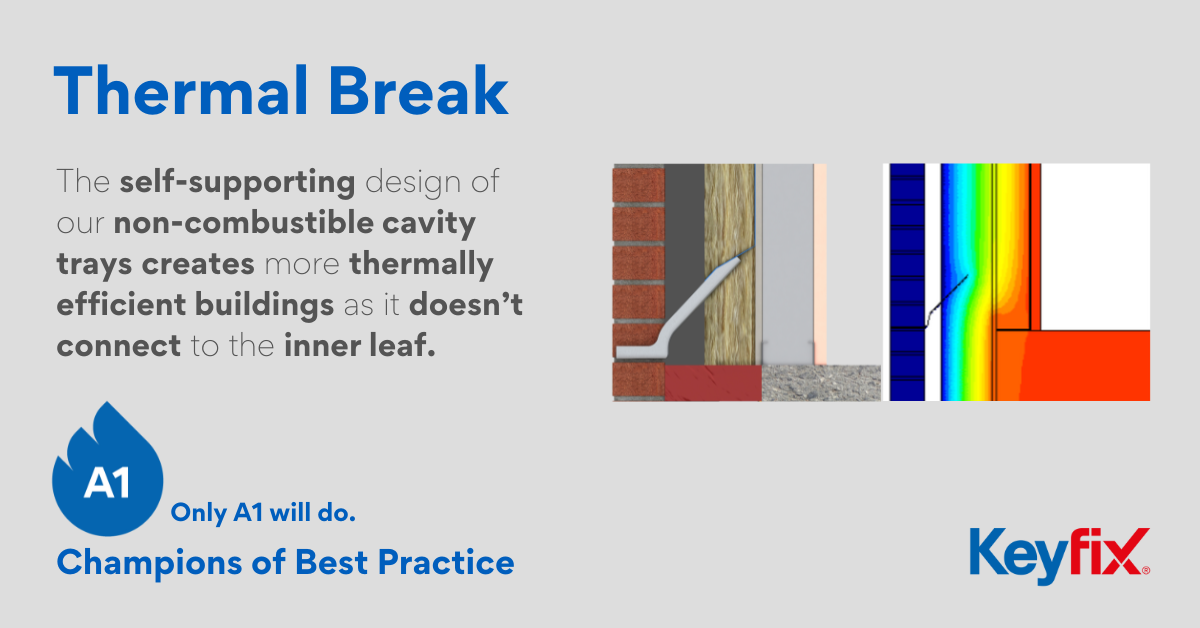
Champions of Best Practice

Posted on 31 Aug 2023
Read Keyfix Managing Director, John Duffin’s latest blog on how the self-supporting design of Keyfix’s Non-combustible Cavity Tray system creates more thermally efficient buildings and the benefits that this brings.
With growing concerns about the rising cost of energy and the environmental impact of heating homes, devising ways of making buildings more thermally efficient is essential. The built environment industry knows that the most important physical principle of making efficient homes is a fabric first approach – yet, this line of thought rarely extends to cavity trays. As champions of best practice, Keyfix has designed its innovative Non-Combustible Cavity Tray (NCCT) to reduce heat transfer from the building.
Cavity trays are damp-proof courses that capture and expel moisture running down the inside surface of the external skin and dripping of Wall Ties etc within the clear cavity. Cavity trays also constitute part of the building’s fabric, yet are rarely looked at as part of it. The fabric of a building is the main culprit for heat loss and with building regulations becoming more stringent, it is within developers’ best interests to reduce Psi-values, as these factor significantly in certain building assessments. One of the optimal methods of minimising thermal heat transmittance is to reduce thermal bridging in building components.
A thermal bridge is an area or component of an object that has higher thermal conductivity than the surrounding materials, creating a path of least resistance for heat transfer. Despite this, the cavity tray market consists of products that are predominantly metal-based. These products, when fixed to the internal skin, form a metal bridge which creates high heat conductivity. This means that this integral component of a building’s fabric creates a path of least resistance for heat, from the warm internal skin, to pass into the cavity and external skin and back out of the building.
At best, decreased interior surface temperatures as a result of thermal bridging will make the building harder to heat and at worst contribute to mould growth which is difficult and costly to repair. Additionally, occupants’ health may be jeapordised by illnesses such as respiratory infections and allergies.
Looking at ways of reducing heat loss is becoming increasingly important in the housing sector as energy efficiency becomes a greater priority in the UK’s race to net-zero. This can be seen in housing regulations becoming more stringent. For example, the new Minimum Energy Efficiency Standards (MEES) legislation requires that from 1st April 2023, property owners must not continue to let properties that have an Energy Performance Certification (EPC) rating of F or G (unless they have an exemption) and all let properties will need to have a minimum EPC rating of E.
Additionally, changes to Approved Document L of the updated Building Regulations, which came into effect in June 2022, constitute a major phase in the government’s plan to become carbon neutral. A key requirement of Part L stipulates that ‘reasonable provision shall be made for the conservation of fuel and power in buildings by limiting heat gains and losses through thermal elements and other parts of the building fabric.’
The Keyfix NCCT is unique from other cavity trays on the market as it is a completely self-supporting system, while other systems are fixed to the internal skin for support. Systems which rely upon fixing back systems to the internal skin create a thermal bridge, making the building harder to heat. Unlike other products, the Keyfix Non-Combustible Cavity Tray system is installed in the outer leaf with no connection whatsoever with the inner skin, therefore allowing the building to retain more heat.
As champions of best practice, we believe that products should provide the best performance possible to ensure that buildings are as efficient as they possibly can be. This is why the Keyfix Non-Combustible Cavity Tray system goes beyond the bare minimum of preventing water ingress, but provides a thermal break between the inner and outer skin of the cavity to make the NCCT instrumental in thermal efficiency. Keyfix’s innovative, multi-faceted NCCT helps specifiers, architects, and brickwork contractors achieve the high standard of design that their building’s occupants deserve.
Discover our latest CPD “Solving the non-combustible Challenge with Keyfix Cavity Tray systems”
Request CPDEnter your name and email address below to keep up to date with Keyfix product developments, CPDs, industry news and much more.